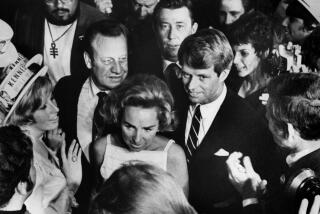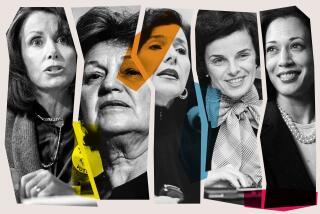Two Women, Two Eras, Two Role Models : First Ladies: In the ‘60s, we adored Jackie. In the ‘90s, we analyze Hillary. What a difference three decades makes in our perception of the ‘ideal woman.’
- Share via
WASHINGTON — One was the perfect hostess who charmed the world and redefined the title of First Lady with her style, elegance and dignity.
The other, a driven professional who wins admiration with her eloquence, intellect and unflinching determination, is revolutionizing the role of presidential spouse.
Three decades separate the reigns of Jacqueline Kennedy Onassis and Hillary Rodham Clinton, and no two women better illustrate the sea change in public perception of the “ideal woman.”
“It’s a very different image,” said Brenda Castro, 50, one of hundreds of longtime Jackie admirers who assembled at Arlington National Cemetery on Monday to bid her farewell. “Jackie’s from an era of grace and elegance, when women were supposed to be charming hostesses and adoring wives. Hillary is from a different era. She’s from an era when you should get an education and go out and make change and be very verbal about it.”
But both women stand apart from other First Ladies because they epitomize--Jackie for the 1960s and Hillary for the 1990s--what a woman “should be.”
As she waited for the motorcade carrying Jackie Kennedy Onassis’ body, Jenifer Lucas, 48, of Arlington, Va., said the difference between the two First Ladies reflected the amazing metamorphosis American women have made in recent years.
As a young woman in the early 1960s in Topeka, Kan., she said, she aspired to be like Jackie Kennedy. “She epitomized so much of what girls of our age were brought up to think we should be,” Lucas said.
But now, as an attorney for the Federal Energy Regulatory Commission, she looks to Hillary Clinton as a role model.
“We grew up in a time when women were expected to be educated but not have careers,” she said. “You were supposed to be a supportive wife, a gracious hostess and a good mother. That was Jackie. Now women are expected to have successful careers. That’s Hillary.”
Castro, Lucas and other women gathered along the avenue leading to the cemetery recalled the impact Jackie Kennedy had on American women of all ages, ethnic backgrounds and economic classes, starting with the 1960 presidential campaign. She showed them that a woman could be a supportive wife and mother, dazzle people with her looks and still have an identity of her own.
“I remember voting for her,” Castro said enthusiastically, making it clear that in her view, casting a vote for JFK was casting a vote for Jackie as well. “It was John and Jackie, not just John.”
Not until the Clintons started campaigning did Castro again feel that she was supporting a couple and not just a candidate.
With her pillbox hats, command of foreign languages and dashing, accomplished husband, Jackie was the standard of a successful woman in the early 1960s.
“Hillary does that now for people my age and younger because she speaks on the issues we care about,” Castro said. “But she’s a totally different woman, and we admire different things in her. She’s intelligent, forceful without being aggressive, focused, directed, accomplished.”
In Hillary Clinton’s unprecedented 66-minute news conference in April, she presented herself as a “transitional” First Lady. Dressed in pink to highlight her traditional femininity, she expertly defended her role in making unusually successful investments for her family.
*
Doris Kearns Goodwin, the author of “The Fitzgeralds and the Kennedys,” argues that Jackie Kennedy was also a transitional First Lady. Although she was praised for being ladylike and having unrivaled fashion sense, she helped in her own way to open the door for the women’s movement.
“There was an independence in the way she approached the first ladyship,” Goodwin said. “Even though she was doing traditional feminine interests--art, culture and fashion--she was independent in how she pursued them. She was a symbol of the coming independence of women to do as they like.”
Goodwin stressed that it was much easier in the 1960s, when the media spotlight did not shine so relentlessly, for a First Lady to become a public idol. People saw Jackie when she wanted to be seen, and they hardly ever heard her speak. To most Americans, she was the silent, dignified image that she projected on television screens and in the newspapers.
“Some of Jackie’s majesty depended on her mystery,” Goodwin said. “I’m not sure that kind of political celebrity can exist today. We know so much more today about everyone.”
Jackie Kennedy, for instance, was never pressed by reporters about her husband’s infidelities. But Hillary Clinton had to face such questions before and after her husband came to office.
Hillary Clinton, who has described herself as a very private person, clearly envies the distance Jackie Kennedy was able to create between her family and the press. The morning after Jacqueline Kennedy Onassis died, Hillary Clinton told CNN how grateful she was for conversations that the two First Ladies had had about “how she had managed so well to carve out the space and privacy that children need to grow into what they have a right to become.”
To be a role model in the 1990s, Goodwin said, takes a woman like Hillary Clinton, who can dazzle the Senate with her intellect rather than her wardrobe. “What Hillary has going for her is a whole generation of women trying to do what she’s doing--balancing a career and a family life.”
If the Jackie Kennedy the world knew in the 1960s was in the White House today, “she would not have a connection to young women of today’s generation the way Hillary does,” she added.
*
Paul Costello, deputy press secretary for former First Lady Rosalynn Carter, said the two First Ladies are also exceptional among the women who have held that title because they changed the job description for the spouse of a President.
“Every First Lady since Jackie Kennedy has been judged by the standard of style and elegance that she set in the White House,” Costello said. “Every First Lady post-Hillary will be judged by her standard of substance.”
But not everyone agrees that Hillary Clinton represents the ideal woman of the 1990s.
“The way a First Lady would more accurately reflect the evolution of the role of a woman would be to leave the White House every day and go to a job that is not dependent on her husband,” said Sheila Tate, press secretary first to Nancy Reagan and then to George Bush’s successful 1988 presidential campaign.
“Hillary Clinton’s role is really no different from any other First Lady’s because she has borrowed her husband’s power. Very few women in America have had authority handed to them. They have had to earn it.”
More to Read
Sign up for Essential California
The most important California stories and recommendations in your inbox every morning.
You may occasionally receive promotional content from the Los Angeles Times.













